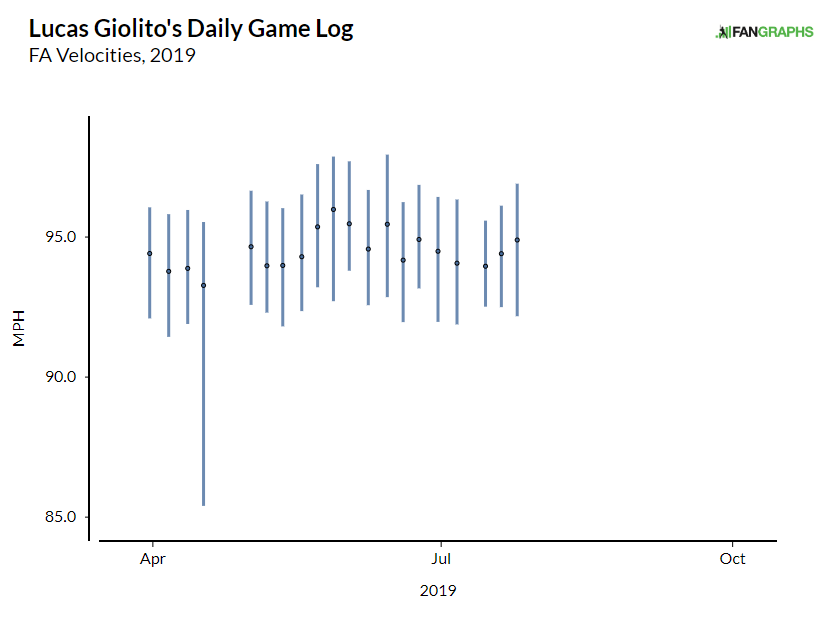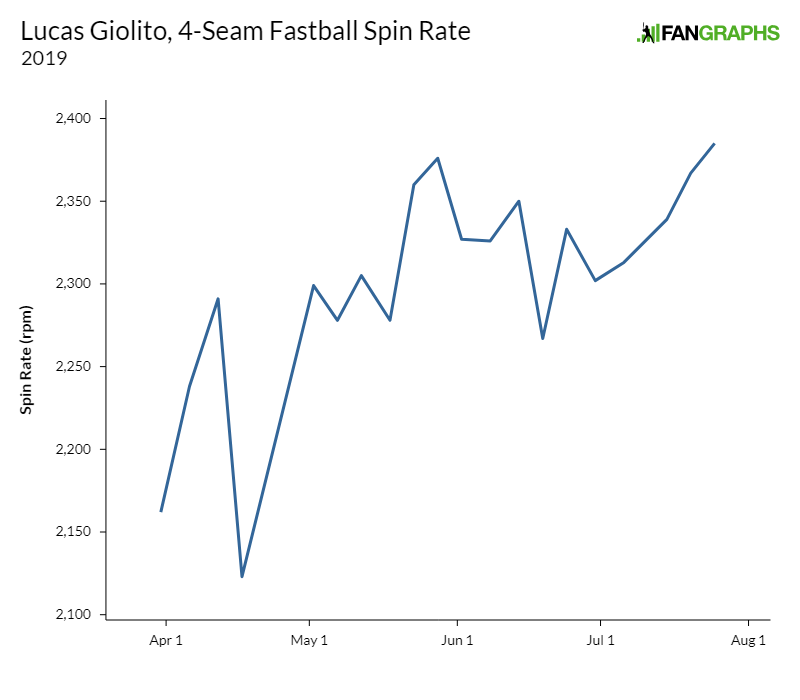Lucas Giolito’s Rough July Was Just a Blip
If you just glanced at his player page for a second, you might think Lucas Giolito was falling apart. After a triumphant first half, during which he paired a 30% strikeout rate with a 9.5% walk rate on his way to a 3.15 ERA and 3.23 FIP, he made the All-Star team. And this was no automatic invite extended to the best available White Sox player; he was simply one of the best pitchers in baseball, running comparable park-adjusted numbers to Stephen Strasburg, Walker Buehler, and Zack Greinke.
From that great height, Giolito’s second half has had a rocky beginning. In three post-break starts, he’s compiled a 5.6 ERA, with a FIP over five. A lot of that ugliness is driven by a pasting at the hands of the Twins, when he allowed four home runs and seven runs over five innings, but it’s not as though there weren’t other warning signs. In his last pre-break start, he went only four innings against the Cubs, walking five batters on his way to giving up six earned runs. All told, it was a beyond-forgettable July for Giolito.
Situations like this are among the most difficult for writers to assess. Pitchers are fickle, and there’s no better example of that than Giolito. In parts of three seasons from 2016 to 2018, he was below replacement level, whether you’re into runs allowed or FIP; over 240 innings, he ran a 5.48 ERA and 5.68 FIP. He only struck out 16.2% of batters he faced while walking 11%. He still had some prospect shine, but projection systems weren’t buying it: ZiPS projected him for a 5.03 ERA in a lower-scoring environment than what we’ve realized in 2019, while Steamer foresaw an even higher 5.32 ERA.
Of course, Giolito proceeded to make those projections look ridiculous. Through 16 starts, roughly the first half of his season, he pitched nothing at all like the projections. That 30% strikeout rate was nearly double what the two projection systems expected, and his walk rate was significantly lower — you get the idea. Essentially, Giolito looked like an ace. If there was cause for concern, it was unsustainable home run suppression — he’d allowed a 9.7% HR/FB rate in the first half, and for a fly ball pitcher, that adds up. The point, though, is that Giolito went from replacement-level disappointment to deserving All-Star.
To understand whether his last month’s worth of starts is a blip in his new good form or a return to the wilderness, we need to first understand what changed in the first half of the year. Without understanding that, we’re just guessing. Luckily, it’s not hard to work out what changes he made. Starting with an offseason throwing program, Giolito worked hard to retool his game. He junked his sinker in exchange for more four-seamers and added velocity. He started leaning on his changeup more heavily against lefties. 2019 Lucas Giolito still has the familiar stature and pedigree, but he looks completely different on the mound.
The most obvious change was in his four-seam fastball, the pitch that was his calling card during his time as a top prospect. He added about 1.5 mph of velocity, which is always good, but he also added 200 rpm of spin (pitchers average 24 rpm gained per 1 mph of velo). That spin gave the ball more ride and more horizontal movement, turning the pitch from hittable (14% whiff rate, 16th percentile among starters) to useful (23.7% whiff rate, 77th percentile). I hate to do the thing where I show a pitch from two different years and say “Look how different they are,” because the human eye can always convince itself it sees something different. That said, there’s almost no other way to show Giolito’s change. Look how different they are! First 2018:
Then 2019:
The arm action is totally different, minus the behind-the-back load he used in 2018, and the pitch, while similarly located, has more life to it. The pitch to Betts rose nearly two inches more relative to gravity than the pitch to Perez, the difference between a frustrating foul ball on a perfect pitch and a strikeout of the reigning MVP.
I’m basically comfortable saying that 2019 Giolito, as of the end of June, was a different pitcher compared to his previous self. Projection systems can’t know that a pitcher has reworked his arsenal, or added both velocity and movement to the pitch he throws the most while scrapping an ineffective sinker. The question, then, is whether Giolito’s form has changed in July. Four starts isn’t enough to say, from stats alone, whether a pitcher has changed. Heck, 20 starts probably isn’t. To see any difference, we’re going to have to go down to the pitch level.
First, there’s the velocity. FanGraphs’ graphing tool makes this easy to look up, and everything looks more or less shipshape:

Aside from the normal game-to-game variation, it doesn’t look like anything is amiss. How about spin rate? Has the movement abandoned him?

Again, it doesn’t look like it. If anything, he’s adding spin as the year goes on. The pitch is missing bats as much as ever, as well: his 25.8% fastball whiff rate in July is his highest in any full month. His secondary pitches are much the same: his slider (his go-to secondary against righties) and changeup (for lefties) haven’t budged in usage or whiff rate. Sure, he’ll throw the occasional changeup to a righty, not always the best decision:
Yikes. For the most part, though, his pitches seem to be working as well as ever. His command, as well, looks fine: he’s in the zone at about the same rate he has been all season, a career-high 47.4%. If you bought Lucas Giolito as a good pitcher in June, there’s no reason to think he’s changed at all since then, Nelson Cruz’s personal three-homer crusade notwithstanding.
Giolito isn’t a perfect pitcher, by any means. His changeup is a work in progress, particularly against righties: four of the fourteen home runs he’s given up this year have been changeups to righties, a sure sign that that pitch needs some rethinking given that he only throws it to them 16% of the time.
He sometimes leaves his fastball over the middle too much, though the rise helps — he’s left 9.7% of his fastballs middle-middle this year, which is 80th percentile among starters. That doesn’t keep you from being a good pitcher — Max Scherzer, Lance Lynn, Chris Paddack, and Blake Snell all groove even more fastballs. It does, however, put pressure on the pitch’s movement, which means that a tick down in spin would be particularly worrisome.
Still, I’m picking nits. He has a pitch he can use against lefties — he’s allowed a stingy .194 wOBA and .208 xwOBA on plate appearances ending in a changeup this year. He has one he can use against righties — his slider has run a .211 wOBA and .225 xwOBA over 66 PA. His fastball gets whiffs and fills the zone. Even including the most recent game, he’s running a 3.52 ERA and 3.53 FIP for the season. He’s 13th in WAR among all pitchers, 21st if you want to use RA9-WAR.
There’s an impulse, with pitchers in particular, to read a lot into a single start, a single bad month. Pitching is a fickle act, and pitchers change talent level all the time. One minute you’re Dodgers Rich Hill, the next you’re Atlantic League Rich Hill. In Giolito’s case, however, I think it’s a false alarm. Giolito is a new pitcher in 2019, something wholly unlike what he has been previously in his big league career, and a down month doesn’t change that. The White Sox aren’t competing for anything this year, but their future is bright, and Giolito is a huge part of that future, no matter what a few starts might make you think.
Ben is a writer at FanGraphs. He can be found on Bluesky @benclemens.

I had not watched much of Giolito until this season. Who enjoys watching a dumpster fire, but the change in the arm action in his delivery is as dramatic as any I recall seeing. Much was written while he was in the wilderness that the Nationals made some very substantial changes in his delivery which many blamed for his fall from the top pitching prospect in the game to something much closer to a wash out. I wonder what he looked like when he was being so highly touted? That is the video that would answer some questions.
Reportedly, he spent this past offseason reshaping his delivery with assistance from his high school coach and teammates, so presumably his current delivery is closer to his high school one than whatever the Nationals did.
It’s not. If you look at his old high school scouting videos he always had the long arm action. The short arm action we see now is something he’s never done before.
https://www.youtube.com/watch?v=9n6lNcH9Xyc